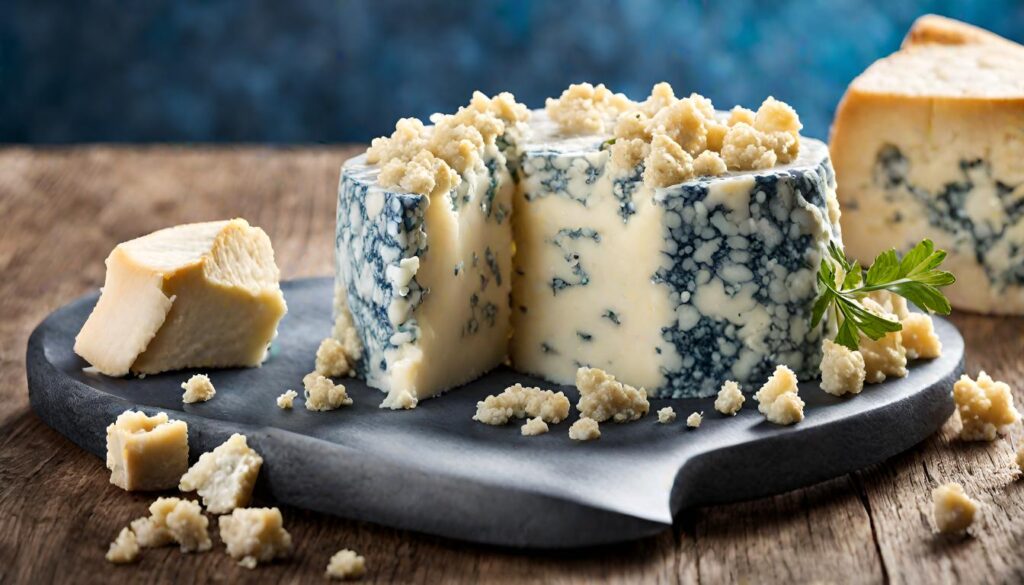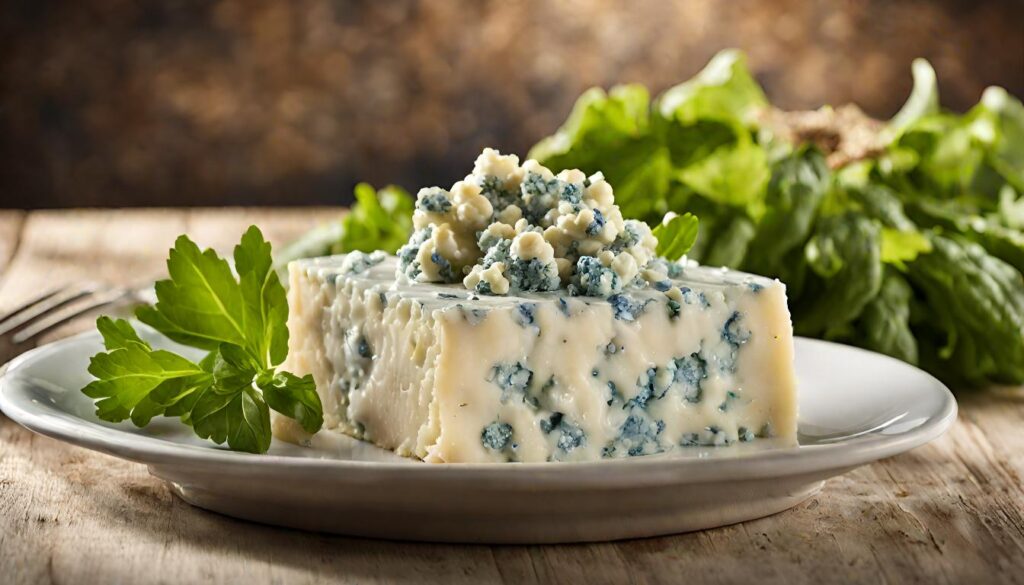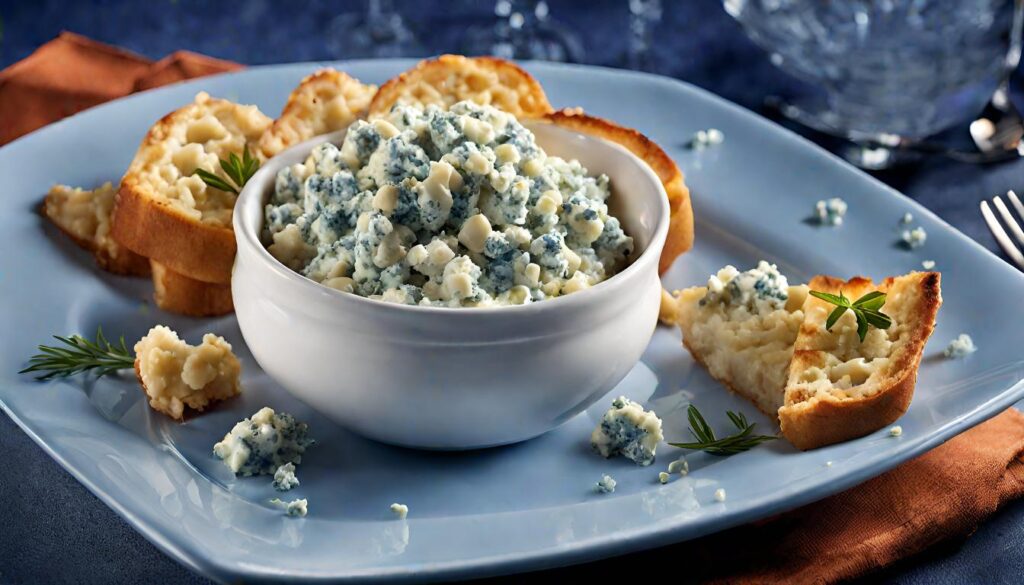Article Introduction:
Blue cheese crumbles, a culinary delight that dances on the taste buds, are more than just a topping for salads and steaks. This article delves into the fascinating world of blue cheese, exploring its rich history, diverse varieties, nutritional benefits, and versatile culinary uses. From the art of selecting the perfect crumbles to answering your most pressing questions, we’ve got it all covered. So, let’s embark on this cheesy journey and unravel the wonders of blue cheese crumbles.
Part 1: Introduction to Blue Cheese Crumbles
What are Blue Cheese Crumbles?
Blue cheese crumbles, those tantalizing bits of flavor, are not just a mere cheese variety; they’re a testament to the art of cheese-making. Blue cheese, known for its distinctive veins of blue or green mold, offers a unique taste profile ranging from sharp and tangy to rich and earthy. When this cheese is crumbled, it transforms into a versatile ingredient that can elevate the simplest dishes to gourmet levels.
But wait, there’s more! Blue cheese crumbles aren’t just about taste. They’re steeped in a history that dates back centuries and have evolved into a modern kitchen staple. In the next section, we’ll dive deeper into this history, tracing the journey of blue cheese from ancient cellars to contemporary cuisines. Stay tuned, as we’re just scratching the surface of this flavorful adventure!
Part 2: The History and Origin of Blue Cheese
From Traditional to Modern: The Evolution of Blue Cheese
Ah, blue cheese! Its story is as rich and complex as its flavor. This cheese, with its distinctive blue streaks, has a history that’s as intriguing as a well-aged wine. Originating in Europe, blue cheese’s birth is shrouded in tales and legends. Some say it was a happy accident, discovered when cheese was stored in caves and became veined with beneficial mold. Others believe it was a stroke of culinary genius by cheese artisans of yore.
Fast forward to today, and blue cheese has undergone a remarkable transformation. From rustic beginnings in European caves, it has traveled across oceans and cultures, finding a place in diverse culinary traditions. It’s not just a cheese anymore; it’s a symbol of gastronomic heritage and innovation.
In the next section, we’ll explore the various types of blue cheese that have emerged from this rich history. Each variety, with its unique characteristics and flavor profile, tells a story of the regions and artisans that crafted them. So, buckle up, cheese lovers! We’re about to embark on a flavorful journey through the world of blue cheese varieties.
external link : “53 Blue Cheese Recipes That’ll Turn You Into a Believer” – Taste of Home:
-
- Link: 53 Blue Cheese Recipes That’ll Turn You Into a Believer
- Source: Taste of Home
- Description: This collection of recipes showcases the diverse and delicious uses of blue cheese crumbles. From Buffalo Chicken Lasagna to Steak & Blue Cheese Pizza, these recipes demonstrate the versatility and flavourful potential of blue cheese crumbles.
Part 3: Types and Varieties of Blue Cheese
Exploring Different Types of Blue Cheese
Dive into the world of blue cheese, and you’ll find a treasure trove of varieties, each with its own unique character and story. Let’s explore some of the most popular types that have captivated cheese aficionados worldwide.
First up, the famous Roquefort, hailing from France, is a true blue cheese classic. Made from sheep’s milk, it’s known for its rich, tangy flavor with a hint of saltiness. Next, we have Gorgonzola, Italy’s pride. This cheese can range from soft and creamy to crumbly and sharp, depending on its aging.
But wait, there’s more! Stilton, the British contribution to the blue cheese family, stands out with its creamy yet crumbly texture and milder flavor profile. And let’s not forget Danish Blue, a milder and smoother alternative, perfect for those just dipping their toes into the blue cheese world.
Each of these varieties brings something unique to the table, from bold and pungent to mild and creamy. In the next section, we’ll delve into the nutritional profile of blue cheese. Spoiler alert: it’s not just delicious; it’s also packed with health benefits! Stay tuned as we uncover the wholesome goodness hidden in these crumbly delights.
Part 4: Nutritional Profile
Nutritional Benefits of Blue Cheese
While indulging in the delectable world of blue cheese crumbles, it’s comforting to know that this cheesy delight offers more than just exceptional flavor. Let’s explore the nutritional benefits tucked within those creamy, crumbly morsels.
Blue cheese is a valuable source of essential nutrients. It contains a good amount of calcium, which is crucial for bone health. A serving of blue cheese also provides protein, making it a satisfying addition to your meals.
But what sets blue cheese apart is its unique combination of vitamins and minerals. It’s rich in vitamin K, which plays a role in blood clotting and bone metabolism. Additionally, blue cheese contains vitamin B12, essential for nerve function and the production of red blood cells.
Furthermore, blue cheese is abundant in selenium, an antioxidant that supports immune function and protects cells from oxidative damage. It also offers a dose of phosphorus, necessary for healthy bones and teeth.
However, it’s essential to enjoy blue cheese in moderation due to its sodium content, which can contribute to high blood pressure if consumed excessively.
In the next section, we’ll explore the diverse culinary uses of blue cheese crumbles. From savory dishes to delightful desserts, blue cheese adds a touch of sophistication to your kitchen creations. Join us as we dive into the world of culinary delights with blue cheese as our guiding star!
external link: “Flavorful Recipes Featuring Blue Cheese Crumbles” – Food & Wine:
-
- Link: Flavorful Recipes Featuring Blue Cheese Crumbles
- Source: Food & Wine
- Description: This resource highlights creative recipes that go beyond using blue cheese crumbles as a salad topping. Examples include crostini, stuffed peppers, and other mouthwatering dishes, showcasing the versatility of blue cheese crumbles.
Part 5: Culinary Uses of Blue Cheese Crumbles
Culinary Delights: Cooking with Blue Cheese Crumbles
When it comes to culinary creativity, blue cheese crumbles are a chef’s secret weapon. These creamy, tangy morsels can transform ordinary dishes into gourmet delights. Let’s explore the diverse world of culinary uses .
- Sensational Salads: Blue cheese crumbles add a burst of flavor to salads. Whether tossed in a classic Caesar salad or paired with fresh pears and walnuts, they provide a delightful contrast of creaminess and tanginess.
- Steak and Burger Bliss: Elevate your grilled meats by topping them with blue cheese crumbles. The melting cheese combines with the savory juices, creating a decadent sauce-like experience.
- Heavenly Pasta: Blue cheese pasta sauces are a revelation. Creamy, cheesy, and slightly pungent, they coat your pasta in a symphony of flavors.
- Gourmet Pizza: Swap mozzarella for blue cheese crumbles on your pizza for a gourmet twist. Complement with figs, prosciutto, and arugula for a taste explosion.
- Stuffed Delights: Blue cheese-stuffed mushrooms or chicken breasts are a party for your taste buds. The cheese oozes out when you cut into them, adding a burst of flavor.
- Savory Toppings: From baked potatoes to roasted vegetables, blue cheese crumbles make for exquisite toppings. Their creamy texture and bold taste enhance any dish.
-
Dip Dynamism: Whip up a creamy blue cheese dip for your next gathering. It’s the perfect accompaniment for veggies, chips, or chicken wings.
These culinary uses merely scratch the surface of what you can achieve with it in your kitchen. In the next section, we’ll guide you on selecting the best blue cheese and storing it to maintain its impeccable flavor. So, gear up, home chefs! There’s a world of blue cheese culinary wonders waiting to be explored.
external link :“Easy Filet Mignon with Blue Cheese Crumbles” – The Hungry Waitress:
-
- Link: Easy Filet Mignon with Blue Cheese Crumbles
- Source: The Hungry Waitress
- Description: This recipe offers a delightful combination of filet mignon with blue cheese crumbles, making it a perfect choice for special occasions.
Part 6: Buying and Storing Blue Cheese
Guide to Buying and Storing Blue Cheese
As you embark on your culinary journey , it’s essential to know how to choose the right cheese and keep it in its prime condition. Let’s explore the art of selecting and storing blue cheese.
Selecting the Best Blue Cheese Crumbles:
- Texture Matters: When buying blue cheese crumbles, consider the texture you need for your dish. Creamier crumbles work well for dressings and dips, while drier ones are ideal for sprinkling over salads.
- Check the Label: Examine the label for information on the cheese’s origin. Different regions produce blue cheese with varying flavor profiles. Experiment with cheeses from different regions to discover your favorites.
- Smell the Cheese: Give your nose a workout. High-quality blue cheese should have a robust, earthy aroma. Avoid cheeses with off-putting or ammonia-like odors.
- Inspect the Color: Blue cheese should display its signature blue or green veins. The color should be consistent throughout, with no excessive browning or discoloration.
Storing Blue Cheese Crumbles:
- Refrigeration is Key: Store your blue cheese crumbles in the refrigerator at temperatures around 35-40°F (2-4°C). Use an airtight container or resealable plastic bag to prevent odors from permeating the cheese.
- Keep It Dry: Place a piece of parchment paper or wax paper in the container before adding the crumbles. This helps absorb excess moisture and prevents them from becoming too soggy.
- Avoid Freezing: While you can freeze blue cheese, it may alter the texture and crumbliness. It’s best to consume it within a reasonable timeframe.
- Wrap It Right: If your blue cheese came in foil or plastic wrap, keep it in its original packaging until you’re ready to use it. This helps maintain its flavor and prevents it from drying out.
Now that you’re armed with the knowledge of selecting and storing blue cheese, you can confidently embark on your culinary adventures. In the final section, we’ll address some frequently asked questions about It, clearing any lingering doubts and helping you become a blue cheese connoisseur. Stay tuned for more cheesy insights!
external link : “Blue Cheese Corn Salad” – Real Housemoms:
-
- Link: Blue Cheese Corn Salad
- Source: Real Housemoms
- Description: This recipe brings together the contrasting flavors of corn and blue cheese crumbles, resulting in a delicious and vibrant side dish.
Frequently Asked Questions
As we conclude our journey , it’s time to address some common queries and dispel any myths surrounding this delightful cheese variety.
1. Are Blue Cheese Crumbles Safe to Eat During pregnancy?
- While pregnant women are advised to avoid soft and mold-ripened cheeses, blue cheese is generally considered safe because it’s made from pasteurized milk. However, it’s essential to consult with a healthcare professional for personalized guidance.
2. How Can I Reduce the Strong Flavor of Blue Cheese?
- If you find the taste of blue cheese too intense, you can try milder varieties or use it sparingly in recipes. Combining it with milder cheeses like mozzarella can also help balance the flavor.
3. Can I Use Blue Cheese Crumbles if I’m Lactose Intolerant?
- Blue cheese contains lower levels of lactose compared to fresh cheeses, making it more tolerable for some lactose-intolerant individuals. However, sensitivity varies, so it’s advisable to monitor your body’s response.
4. What Are Some Creative Recipes with Blue Cheese Crumbles?
- It can be used in various recipes, from salads to sauces. Some creative ideas include blue cheese-stuffed burgers, pear and blue cheese tarts, or a blue cheese and walnut pasta.
5. Is Blue Cheese Crumbles Gluten-Free?
- Typically, blue cheese is gluten-free as it’s made from milk and the mold Penicillium. However, cross-contamination can occur during processing, so it’s essential to check labels for any added ingredients.
6. How Can I Prevent Blue Cheese Crumbles from Drying Out?
- To keep It fresh, store them in an airtight container in the refrigerator with a piece of parchment paper to absorb excess moisture. This helps maintain their texture and flavor.
Now that we’ve addressed these common questions, you’re armed with a deeper understanding of blue cheese crumbles. Whether you’re a seasoned blue cheese enthusiast or a newbie eager to explore, we hope this article has enriched your knowledge and appreciation of this flavorful cheese. Happy cheesemaking and culinary adventures!
Wrapping Up: The Wonders of Blue Cheese Crumbles
As we conclude our savory journey , we’ve explored the rich history, diverse varieties, nutritional benefits, and versatile culinary uses of this cheese variety. From ancient cheese caves to modern kitchens, It have left an indelible mark on the culinary world.
We’ve learned how to select the perfect blue cheese, store it to preserve its flavors, and even addressed common questions and misconceptions. Now, armed with a treasure trove of knowledge, you’re ready to embark on your own culinary adventures with blue cheese crumbles.
So, whether you’re whipping up a gourmet salad, adding a flavorful twist to your pasta, or savoring a blue cheese-stuffed burger, may your culinary creations be filled with the creamy, tangy goodness of blue cheese crumbles.
Now, it’s time to put your newfound knowledge to the test and let your taste buds dance to the tune of this exquisite cheese. Bon appétit, cheese lovers!











